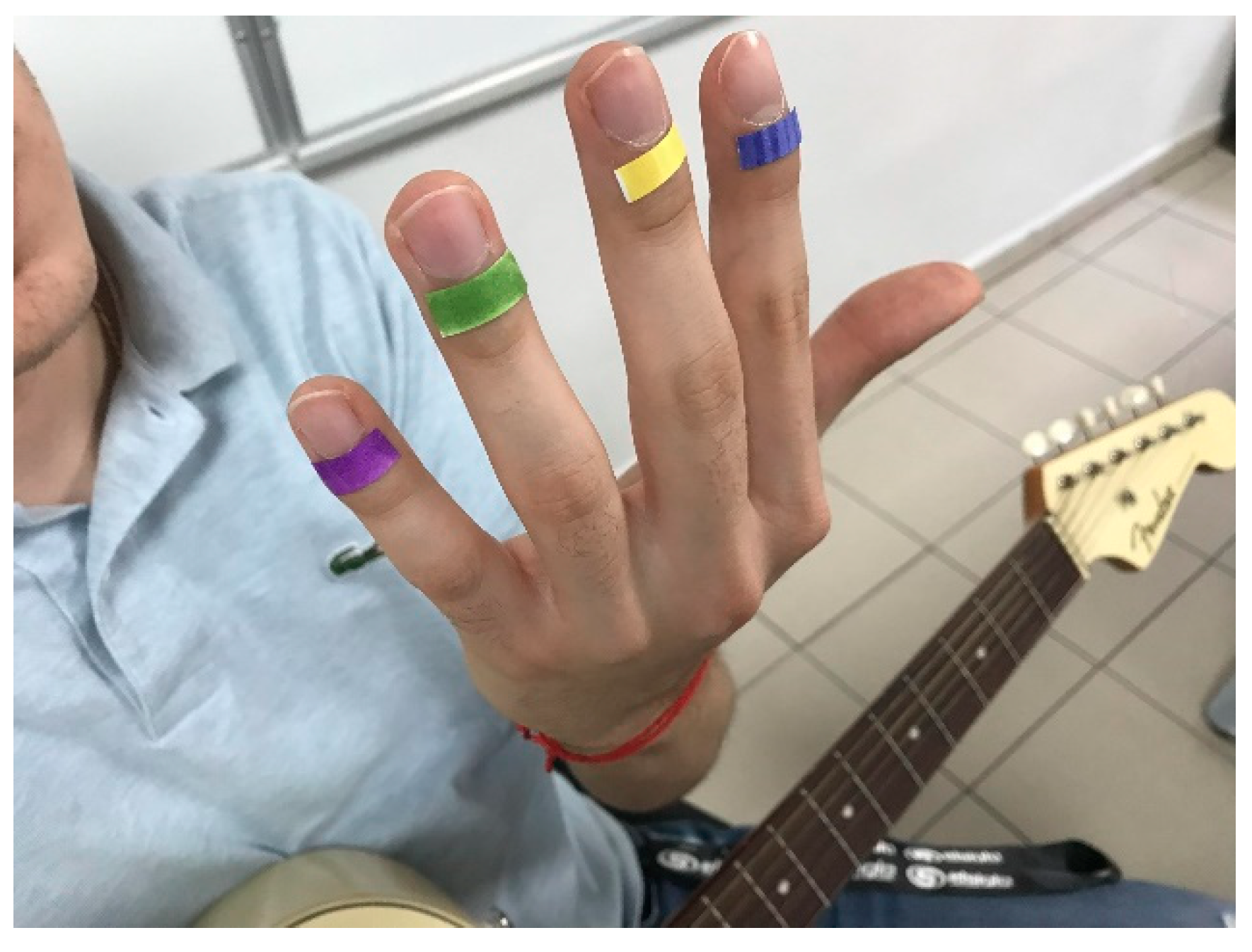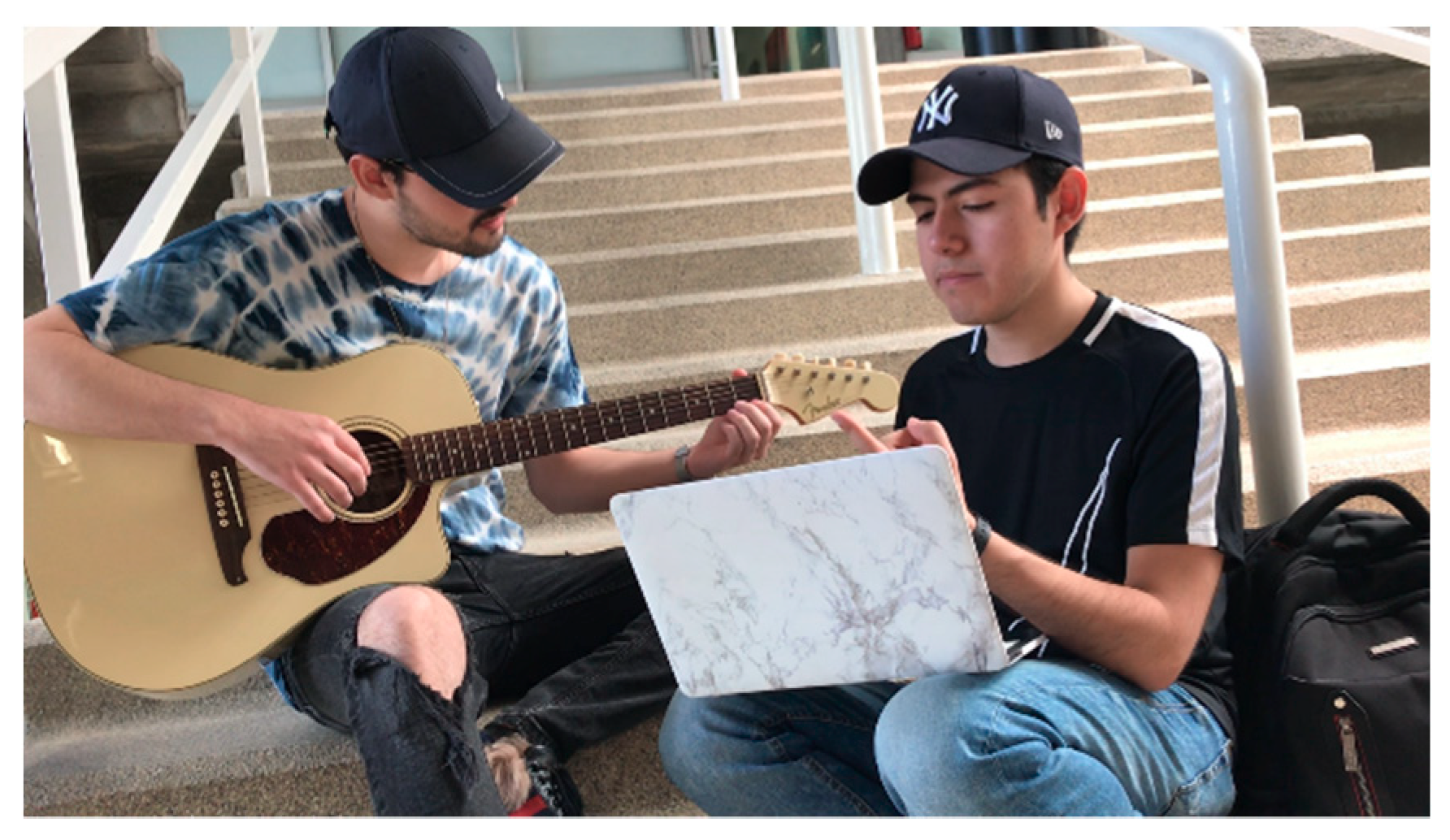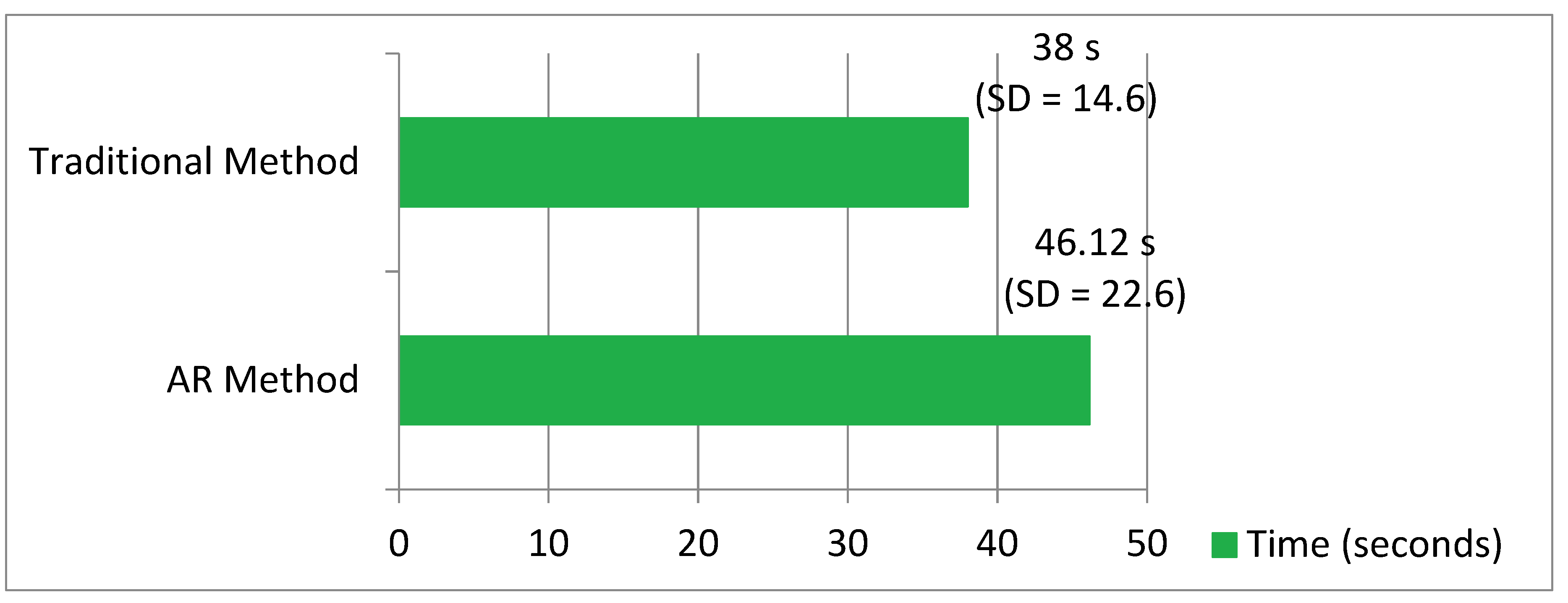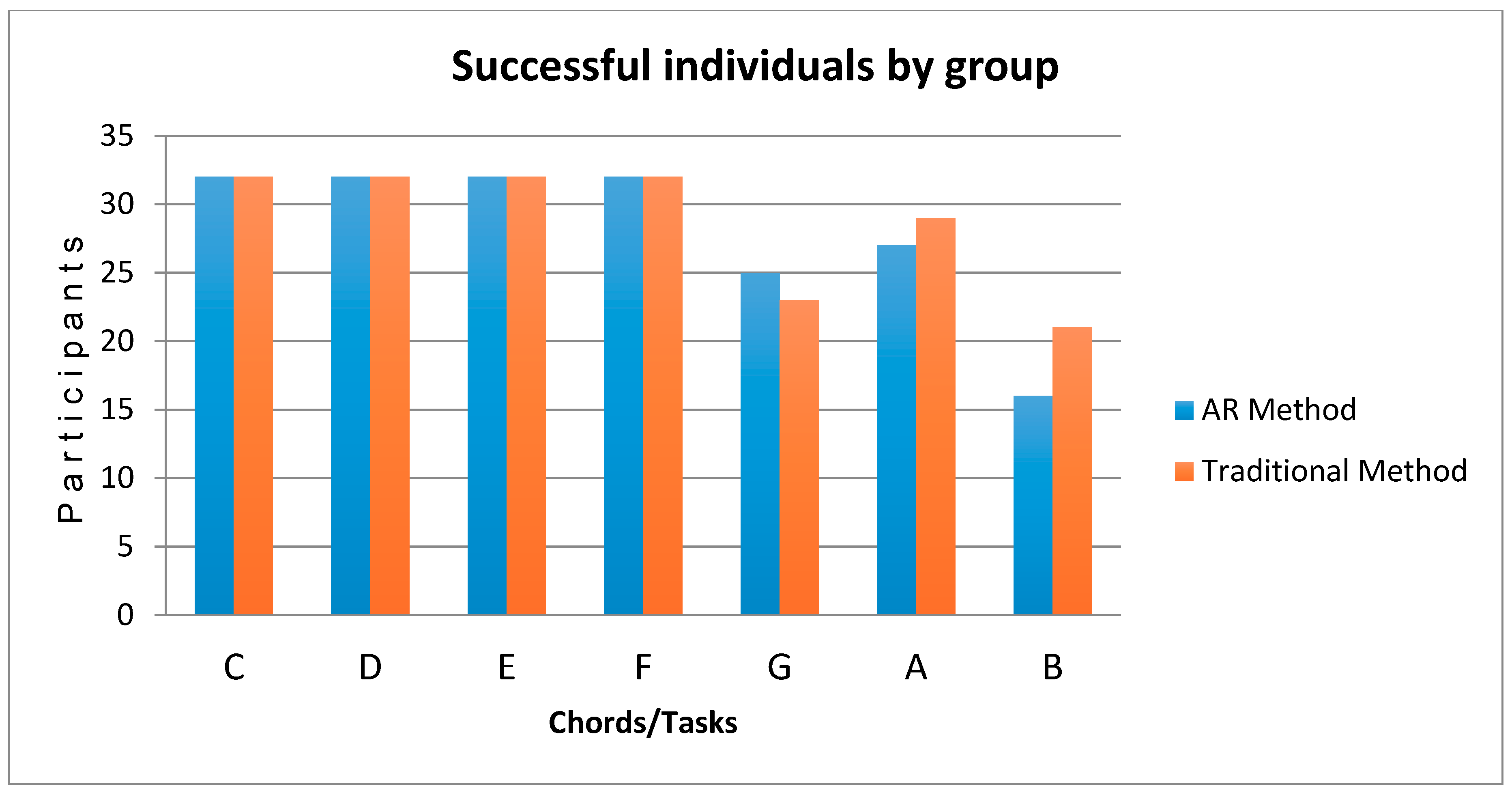AR Graphic Representation of Musical Notes for Self-Learning on Guitar
Abstract
Featured Application
Abstract
1. Introduction
2. Related Works
2.1. Studies of Augmented Reality Applied to Musical Instruments
2.2. Learning Guitar with Augmented Reality
2.3. Auditory Reality
2.4. Guitar Chord Classification System
3. Materials and Methods
- Ho1: The time taken to learn the basic musical chords on the guitar does not depend on the methodology used.
- Ho2: The gender of participants does not affect the time taken.
- Ha1: The methodology used does affect the time taken.
- Ha2: The gender of participants does affect the time taken.
3.1. Archetype and Screener
3.2. Participants
3.3. Equipment
3.4. Experimental Study
3.4.1. Procedure
3.4.2. Tasks
4. Results
4.1. Analysis of Results
- The time taken to learn the basic musical chords on the guitar did not depend on the methodology used.
- The gender of participants did not affect the time taken.
4.2. User Feedback
4.3. Observational Findings
5. Conclusions
Author Contributions
Funding
Acknowledgments
Conflicts of Interest
References
- Schafer, R. The Soundscape: Our Sonic Environment and the Tuning of the World; Inner Traditions Bear and Company Rochester: Rochester, VT, USA, 1999. [Google Scholar]
- Ramirez, R.; Canepa, C.; Ghisio, S.; Kolykhalova, K.; Mancini, M.; Volta, E.; Volpe, G.; Giraldo, S.; Mayor, O.; Perez, A.; et al. Enhancing Music Learning with Smart Technologies. In Proceedings of the 5th International Conference on Movement and Computing-MOCO ’18, Genoa, Italy, 28–30 June 2018; pp. 1–4. [Google Scholar]
- Alonso-Jartin, R.; Chao-Fernández, R. Creatividad en el aprendizaje instrumental lenguaje metafórico, velocidad del procesamiento cognitivo y cinestesia. Creat. Soc. Rev. Asoc. Para Creat. 2018, 28, 7–30. [Google Scholar]
- Trujano, F.; Khan, M.; Maes, P. ARPiano Efficient Music Learning Using Augmented Reality. In Lecture Notes in Computer Science, Proceedings of the Innovative Technologies and Learning -ICITL 2018, Portoroz, Slovenia, 27-30 August 2018; Wu, T.T., Huang, Y.M., Shadiev, R., Lin, L., Starčič, A., Eds.; Springer: Cham, Switzerland, 2018; Volume 11003, pp. 3–17. [Google Scholar]
- Harrison, E. Challenges Facing Guitar Education. Music Educ. J. 2010, 97, 50–55. [Google Scholar] [CrossRef]
- Motokawa, Y.; Saito, H. Support System Using Augmented Reality Display for Use in Teaching the Guitar. J. Inst. Image Inf. Telev. Eng. 2007, 61, 789–796. [Google Scholar] [CrossRef]
- Längler, M.; Nivala, M.; Gruber, H. Peers, parents and teachers: A case study on how popular music guitarists perceive support for expertise development from ‘persons in the shadows’. Music. Sci. 2018, 22, 224–243. [Google Scholar] [CrossRef]
- Keebler, J.R.; Wiltshire, T.J.; Smith, D.C.; Fiore, S.M.; Bedwell, J.S. Shifting the paradigm of music instruction: Implications of embodiment stemming from an augmented reality guitar learning system. Front. Psychol. 2014, 5, 471. [Google Scholar] [CrossRef]
- Schön, A. Educating the Reflective Practicioner; Jossey-Bass: San Francisco, CA, USA, 1987. [Google Scholar]
- Löchtefeld, M.; Krüger, A.; Gehring, S.; Jung, R. GuitAR-Supporting guitar learning through mobile projection. In Proceedings of the Conference on Human Factors in Computing Systems, Vancouver, BC, Canada, 7–12 May 2011; pp. 1447–1452. [Google Scholar]
- Waldron, J.; Mantie, R.; Partti, H.; Tobias, E.S. A brave new world: Theory to practice in participatory culture and music learning and teaching. Music Educ. Res. 2018, 20, 289–304. [Google Scholar] [CrossRef]
- Gaunt, H. One-to-one tuition in a conservatoire: The perceptions of instrumental and vocal students. Psychol. Music 2010, 38, 178–208. [Google Scholar] [CrossRef]
- Gaunt, H. Understanding the one-to-one relationship in instrumental/vocal tuition in Higher Education: Comparing student and teacher perceptions. Br. J. Music Educ. 2011, 28, 159–179. [Google Scholar] [CrossRef]
- Bjøntegaard, B.J. A combination of one-to-one teaching and small group teaching in higher music education in Norway—A good model for teaching? Br. J. Music Educ. 2015, 32, 23–36. [Google Scholar] [CrossRef]
- Alonso-Jartín, R.; Chao-Fernández, R. Aprendiendo a enseñar un instrumento musical en edades tempranas. In Fórmulas Docentes de Vanguardia; Cantalapiedra, B., Aguilar, P., Requeijo, P., Eds.; Gedisa: Barcelona, Spain, 2018; pp. 27–35. [Google Scholar]
- Wych, G.M.F. Gender and Instrument Associations, Stereotypes, and Stratification. Update Appl. Res. Music Educ. 2012, 30, 22–31. [Google Scholar] [CrossRef]
- Hallam, S.; Rogers, L.; Creech, A. Gender differences in musical instrument choice. Int. J. Music Educ. 2008, 26, 7–19. [Google Scholar] [CrossRef]
- Keebler, J.R.; Wiltshire, T.J.; Smith, D.C.; Fiore, S.M. Picking Up STEAM: Educational Implications for Teaching with an Augmented Reality Guitar Learning System. Comput. Vis.–ECCV 2012 2013, 8022, 170–178. [Google Scholar]
- Chao-Fernandez, R.; Román-García, S.; Chao-Fernandez, A. Analysis of the use of ICT through Music Interactive Games as Educational Strategy. Procedia-Soc. Behav. Sci. 2017, 237, 576–580. [Google Scholar] [CrossRef]
- Kerdvibulvech, C.; Saito, H. Vision-Based Guitarist Fingering Tracking Using a Bayesian Classifier and Particle Filters. In Advances in Image and Video Technology; Springer: Berlin/Heidelberg, Germany, 2007; pp. 625–638. [Google Scholar]
- Liarokapis, F. Augmented reality scenarios for guitar learning. In Proceedings of the Theory and Practice of Computer Graphics 2005, TPCG 2005-Eurographics UK Chapter Proceedings, Canterbury, UK, 14 March 2005; pp. 163–170. [Google Scholar]
- Pedgley, O.; Norman, E.; Armstrong, R. Materials-inspired innovation for acoustic guitar design. METU J. Fac. Archit. 2009, 29, 157–174. [Google Scholar]
- Havre, S.J.; Väkevä, L.; Christophersen, C.R.; Haugland, E. Playing to learn or learning to play? Playing Rocksmith to learn electric guitar and bass in Nordic music teacher education. Br. J. Music Educ. 2019, 36, 21–32. [Google Scholar] [CrossRef]
- Hakim, N.L.; Sun, S.W.; Hsu, M.H.; Shih, T.K.; Wu, S.J. Virtual guitar: Using real-time finger tracking for musical instruments. Int. J. Comput. Sci. Eng. 2019, 18, 438–450. [Google Scholar] [CrossRef]
- Graham, K.; Schofield, D. Rock god or game guru: Using Rocksmith to learn to play a guitar. J. Music Technol. Educ. 2018, 11, 65–82. [Google Scholar] [CrossRef]
- Martins, V.F.; Gomes, L.; de Guimarães, M. Challenges and possibilities of use of augmented reality in education case study in music education. In Lecture Notes in Computer Science, Proceedings of the Computational Science and Its Applications -ICCSA 2015, Banff, Canada, 22–25 June 2015; Gervasi, O., Murgante, B., Misra, S., Gavrilova, M.L., Rocha, A.M.A.C., Torre, C.M., Taniar, D., Apduhan, B.O., Eds.; Springer: Cham, Switzerland, 2015; Volume 9159, pp. 223–233. [Google Scholar]
- Kerdvibulvech, C.; Saito, H. Guitarist Fingertip Tracking by Integrating a Bayesian Classifier into Particle Filters. Adv. Hum.-Comput. Interact. 2008, 2008, 1–10. [Google Scholar] [CrossRef]
- Hackl, D.; Anthes, C. HoloKeys-An augmented reality application for learning the piano. In Proceedings of the 10th Forum Media Technology and 3rd All Around Audio Symposium, St. Pölten, Austria, 29–30 November 2017; pp. 140–144. [Google Scholar]
- Rogers, K.; Röhlig, A.; Weing, M.; Gugenheimer, J.; Könings, B.; Klepsch, M.; Schaub, F.; Rukzio, E.; Seufert, T.; Weber, M. PIANO: Faster Piano Learning with Interactive Projection. In Proceedings of the Ninth ACM International Conference on Interactive Tabletops and Surfaces-ITS ’14, Dresden, Germany, 16–19 November 2014; pp. 149–158. [Google Scholar]
- Akbari, M.; Liang, J.; Cheng, H. A real-time system for online learning-based visual transcription of piano music. Multimed. Tools Appl. 2018, 77, 25513–25535. [Google Scholar] [CrossRef]
- Turchet, L.; Fischione, C.; Essl, G.; Keller, D.; Barthet, M. Internet of Musical Things: Vision and Challenges. IEEE Access 2018, 6, 61994–62017. [Google Scholar] [CrossRef]
- Tan, K.L.; Lim, C.K. Development of traditional musical instruments using augmented reality (AR) through mobile learning. AIP Conf. Proc. 2018, 2016, 020140. [Google Scholar]
- Patzer, B.; Smith, D.C.; Keebler, J.R. Novelty and Retention for Two Augmented Reality Learning Systems. Proc. Hum. Factors Ergon. Soc. Annu. Meet. 2014, 58, 1164–1168. [Google Scholar] [CrossRef]
- Del Rio Guerra, M.; Martín-Gutiérrez, J.; Vargas-Lizárraga, R.; Garza-Bernal, I. Determining which touch gestures are commonly used when visualizing physics problems in augmented reality. In Lecture Notes in Computer Science, Proceedings of the Virtual, Augmented and Mixed Reality -VAMR2018, Las Vegas, USA, 15–20 July 2018; Chen, J., Fragomeni, G., Eds.; Springer: Cham, Switzerland, 2018; Volume 10909, pp. 3–12. [Google Scholar]
- Motokawa, Y.; Saito, H. Support system for guitar playing using augmented reality display. In Proceedings of the 2006 IEEE/ACM International Symposium on Mixed and Augmented Reality, Santa Barbard, CA, USA, 22–25 October 2006; pp. 243–244. [Google Scholar]
- Guerrero-Turrubiates, J.D.J.; Ledesma, S.; Gonzalez-Reyna, S.E.; Avina-Cervantes, G.; Ilunga-Mbuyamba, E.; Avina-Cervantes, J.G. Guitar audio signal classification by collapsed Pitch Class Profile. In Proceedings of the 2016 IEEE International Autumn Meeting on Power, Electronics and Computing (ROPEC), Ixtapa, Mexico, 9–11 November 2016; pp. 1–6. [Google Scholar]
- Van Solingen, R.; Basili, V.; Caldiera, G.; Rombach, H.D. Goal Question Metric (GQM) Approach. In Encyclopedia of Software Engineering; John Wiley & Sons, Inc.: Hoboken, NJ, USA, 2002. [Google Scholar]
- Kashiwagi, Y.; Ochi, Y. A Study of Left Fingering Detection Using CNN for Guitar Learning. In Proceedings of the 2018 International Conference on Intelligent Autonomous Systems (ICoIAS), Singapore, 1–3 March 2018; pp. 14–17. [Google Scholar]
- Silla, C.N.; Przybisz, A.L.; Rivolli, A.; Gimenez, T.; Barroso, C.; Machado, J. Girls, music and computer science. In Proceedings of the 2018 IEEE Frontiers and Education (FIE), San Jose, CA, USA, 3–6 October 2018; pp. 1–6. [Google Scholar]
- Kurtz-Costes, B.; Copping, K.E.; Rowley, S.J.; Kinlaw, C.R. Gender and age differences in awareness and endorsement of gender stereotypes about academic abilities. Eur. J. Psychol. Educ. 2014, 29, 603–618. [Google Scholar] [CrossRef]
- Vogel, S.A. Gender Differences in Intelligence, Language, Visual-Motor Abilities, and Academic Achievement in Students with Learning Disabilities. J. Learn. Disabil. 1990, 23, 44–52. [Google Scholar] [CrossRef] [PubMed]
- Nielsen, J. Estimating the number of subjects needed for a thinking aloud test. Int. J. Hum. Comput. Stud. 1994, 41, 385–397. [Google Scholar] [CrossRef]
- Hwang, W.; Salvendy, G. Number of people required for usability evaluation. Commun. ACM 2010, 53, 130–133. [Google Scholar] [CrossRef]
- Thomas, N. Usability Geek. How to Use the System Usability Scale (SUS) to Evaluate the Usability. Available online: https://usabilitygeek.com/how-to-use-the-system-usability-scale-sus-to-evaluate-the-usability-of-your-website/ (accessed on 28 September 2019).
- Bangor, A.; Kortum, P.; Miller, J. Determining What Individual SUS Scores Mean: Adding an Adjective Rating Scale. J. Usabil. Stud. 2009, 4, 114–123. [Google Scholar]
- da Silva, M.M.O.; Teixeira, J.M.X.N.; Cavalcante, P.S.; Teichrieb, V. Perspectives on how to evaluate augmented reality technology tools for education: A systematic review. J. Braz. Comput. Soc. 2019, 25, 3. [Google Scholar] [CrossRef]
- Kularbphettong, K.; Roonrakwit, P.; Chutrtong, J. Effectiveness of enhancing classroom by using augmented reality technology. In Advances in Intelligent Systems and Computing, Proceedings of the International Conference on Human Factors in Traning, Education, and Learning Sciences, Orlando, USA, 21–25 July 2018; Nazir, S., Teperi, A.M., Polak-Sopinska, A., Eds.; Springer: Cham, Switzerland, 2019; Volume 785, pp. 125–133. [Google Scholar]






| Study | Instrument | Technology Used | Users/Sample | Age | Scope |
|---|---|---|---|---|---|
| [4] Trujano et al. (2018) | Piano | AR Piano App Goggles | None | - | Located the exact key to press on a piano. |
| [28] Hackl and Anthes (2017) | Piano | HoloLens Software Unity, Vuforia C# | 2 | unknown | Located piano key positions. |
| [8] Keebler et al. (2014) | Guitar | Fretlight Studio v5.02. Webcam Audacity software | 55 | >18 | The authors proposed that new technologies using AR could be used to reduce the learning barrier faced when learning to play music. |
| [10] Löchtefeld et al. (2011) | Guitar | Laser projector AAXA L1.v2 Gorillapod Accelerometer Qt. Application | 3 | unknown | The authors proposed that AR could be used to support students by using a mobile projector to help them learn a musical instrument. |
| [6] Motokawa and Saito (2007) | Guitar | USB camera. Computer screen. AR toolkit. | - | - | The authors proposed a system that, using AR, helped students learn how to play guitar by displaying a virtual model of a hand superimposed on a real guitar. |
| [27] Kerdvibulvech and Saito (2008) | Guitar | Two USB cameras. Bayesian classifier. OpenGL. | - | - | The authors proposed a framework that displays finger positioning using automatic tracking. |
| [21] Liarokapis (2005) | Guitar | ARToolKit tracking libraries, API of OpenGL & API of OpenAL. Webcam. | 48 | unknown | A system using audio-visual information was created so that users in different settings and with different levels of experience could learn to play the guitar. |
| [36] De Jesus Guerrero-Turrubiates et al. (2016) | Electric Guitar | No technology | - | - | The authors proposed a methodology that was more straightforward in comparison to the present methodology and that was capable of classifying the different chords on an electric guitar. |
| Present study | Acoustic Guitar | App developed in Unity. Vuforia | 64 | 18–25 | A system that displayed the finger placement for seven basic major chords using colored markers and that was also capable of evaluating whether the chords are correctly played via microphone. |
| Factor | p-Value |
|---|---|
| Method | 0.372 |
| Gender | 0.244 |
| Method–Gender | 0.956 |
| Tasks/Chords | |||||||
|---|---|---|---|---|---|---|---|
| C | D | E | F | G | A | B | |
| T-Student p-value | 0.342 | 0.254 | 0.189 | 0.443 | 0.121 | 0.597 | 0.043 |
© 2019 by the authors. Licensee MDPI, Basel, Switzerland. This article is an open access article distributed under the terms and conditions of the Creative Commons Attribution (CC BY) license (http://creativecommons.org/licenses/by/4.0/).
Share and Cite
Del Rio-Guerra, M.S.; Martin-Gutierrez, J.; Lopez-Chao, V.A.; Flores Parra, R.; Ramirez Sosa, M.A. AR Graphic Representation of Musical Notes for Self-Learning on Guitar. Appl. Sci. 2019, 9, 4527. https://doi.org/10.3390/app9214527
Del Rio-Guerra MS, Martin-Gutierrez J, Lopez-Chao VA, Flores Parra R, Ramirez Sosa MA. AR Graphic Representation of Musical Notes for Self-Learning on Guitar. Applied Sciences. 2019; 9(21):4527. https://doi.org/10.3390/app9214527
Chicago/Turabian StyleDel Rio-Guerra, Marta Sylvia, Jorge Martin-Gutierrez, Vicente A. Lopez-Chao, Rodolfo Flores Parra, and Mario A. Ramirez Sosa. 2019. "AR Graphic Representation of Musical Notes for Self-Learning on Guitar" Applied Sciences 9, no. 21: 4527. https://doi.org/10.3390/app9214527
APA StyleDel Rio-Guerra, M. S., Martin-Gutierrez, J., Lopez-Chao, V. A., Flores Parra, R., & Ramirez Sosa, M. A. (2019). AR Graphic Representation of Musical Notes for Self-Learning on Guitar. Applied Sciences, 9(21), 4527. https://doi.org/10.3390/app9214527








